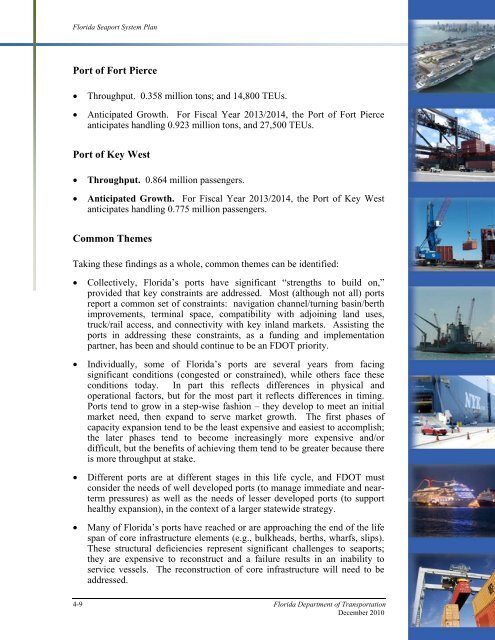Florida Seaport System Plan - SeaCIP
Florida Seaport System Plan - SeaCIP
Florida Seaport System Plan - SeaCIP
Create successful ePaper yourself
Turn your PDF publications into a flip-book with our unique Google optimized e-Paper software.
<strong>Florida</strong> <strong>Seaport</strong> <strong>System</strong> <strong>Plan</strong><br />
Port of Fort Pierce<br />
• Throughput. 0.358 million tons; and 14,800 TEUs.<br />
• Anticipated Growth. For Fiscal Year 2013/2014, the Port of Fort Pierce<br />
anticipates handling 0.923 million tons, and 27,500 TEUs.<br />
Port of Key West<br />
• Throughput. 0.864 million passengers.<br />
• Anticipated Growth. For Fiscal Year 2013/2014, the Port of Key West<br />
anticipates handling 0.775 million passengers.<br />
Common Themes<br />
Taking these findings as a whole, common themes can be identified:<br />
• Collectively, <strong>Florida</strong>’s ports have significant “strengths to build on,”<br />
provided that key constraints are addressed. Most (although not all) ports<br />
report a common set of constraints: navigation channel/turning basin/berth<br />
improvements, terminal space, compatibility with adjoining land uses,<br />
truck/rail access, and connectivity with key inland markets. Assisting the<br />
ports in addressing these constraints, as a funding and implementation<br />
partner, has been and should continue to be an FDOT priority.<br />
• Individually, some of <strong>Florida</strong>’s ports are several years from facing<br />
significant conditions (congested or constrained), while others face these<br />
conditions today. In part this reflects differences in physical and<br />
operational factors, but for the most part it reflects differences in timing.<br />
Ports tend to grow in a step-wise fashion – they develop to meet an initial<br />
market need, then expand to serve market growth. The first phases of<br />
capacity expansion tend to be the least expensive and easiest to accomplish;<br />
the later phases tend to become increasingly more expensive and/or<br />
difficult, but the benefits of achieving them tend to be greater because there<br />
is more throughput at stake.<br />
• Different ports are at different stages in this life cycle, and FDOT must<br />
consider the needs of well developed ports (to manage immediate and nearterm<br />
pressures) as well as the needs of lesser developed ports (to support<br />
healthy expansion), in the context of a larger statewide strategy.<br />
• Many of <strong>Florida</strong>’s ports have reached or are approaching the end of the life<br />
span of core infrastructure elements (e.g., bulkheads, berths, wharfs, slips).<br />
These structural deficiencies represent significant challenges to seaports;<br />
they are expensive to reconstruct and a failure results in an inability to<br />
service vessels. The reconstruction of core infrastructure will need to be<br />
addressed.<br />
4-9 <strong>Florida</strong> Department of Transportation<br />
December 2010
















